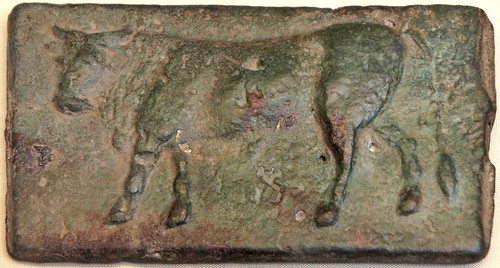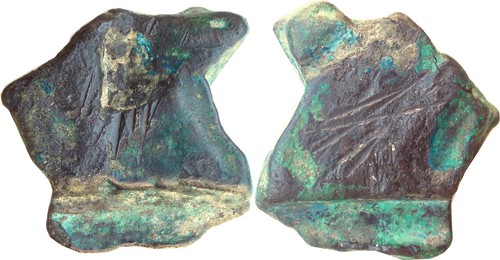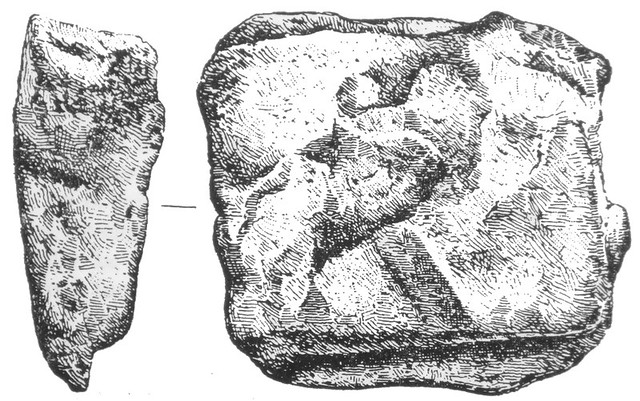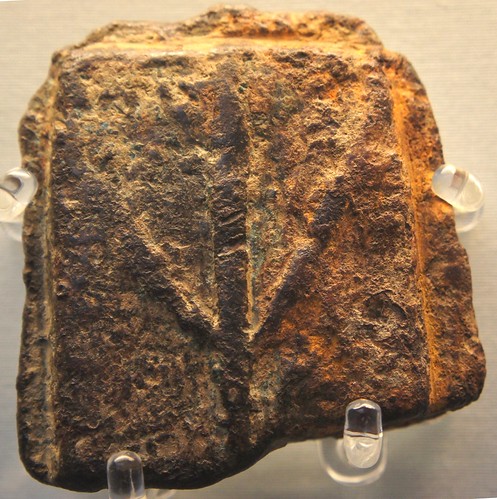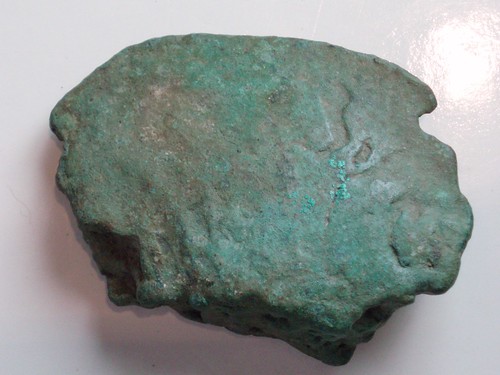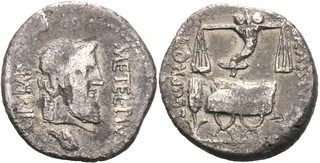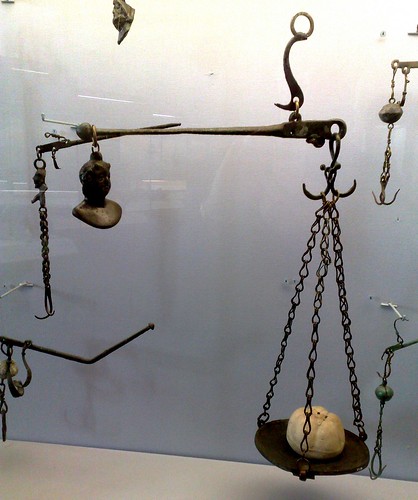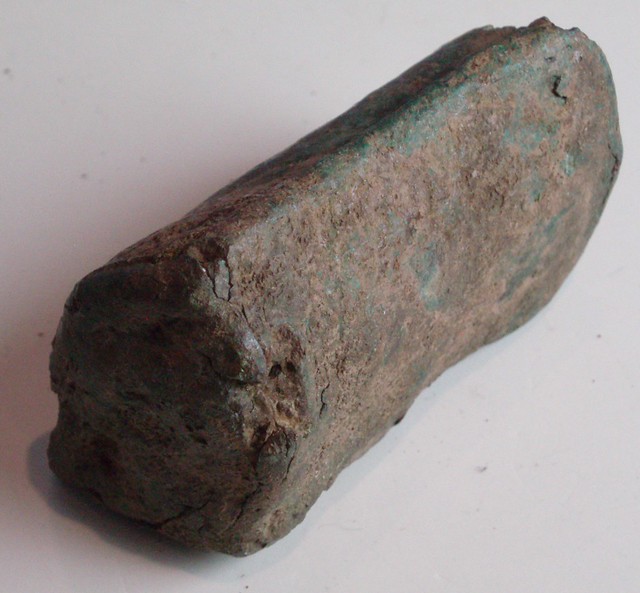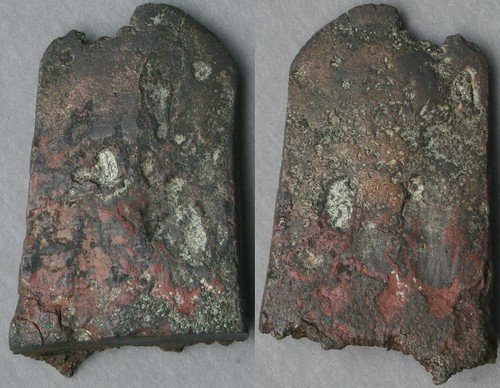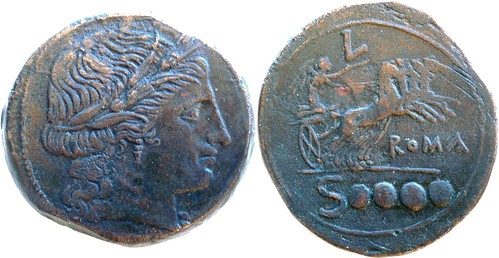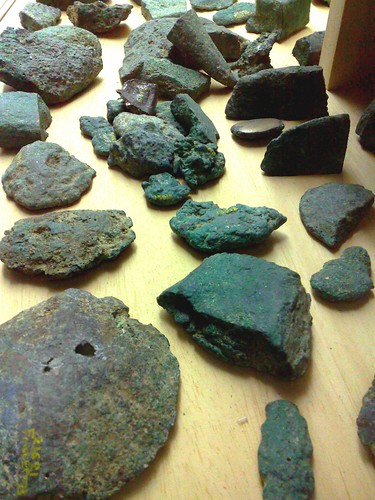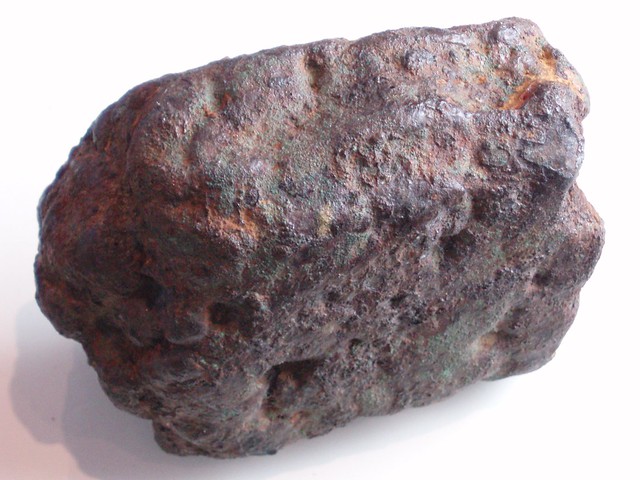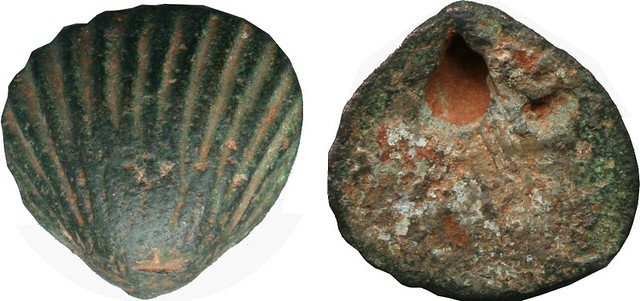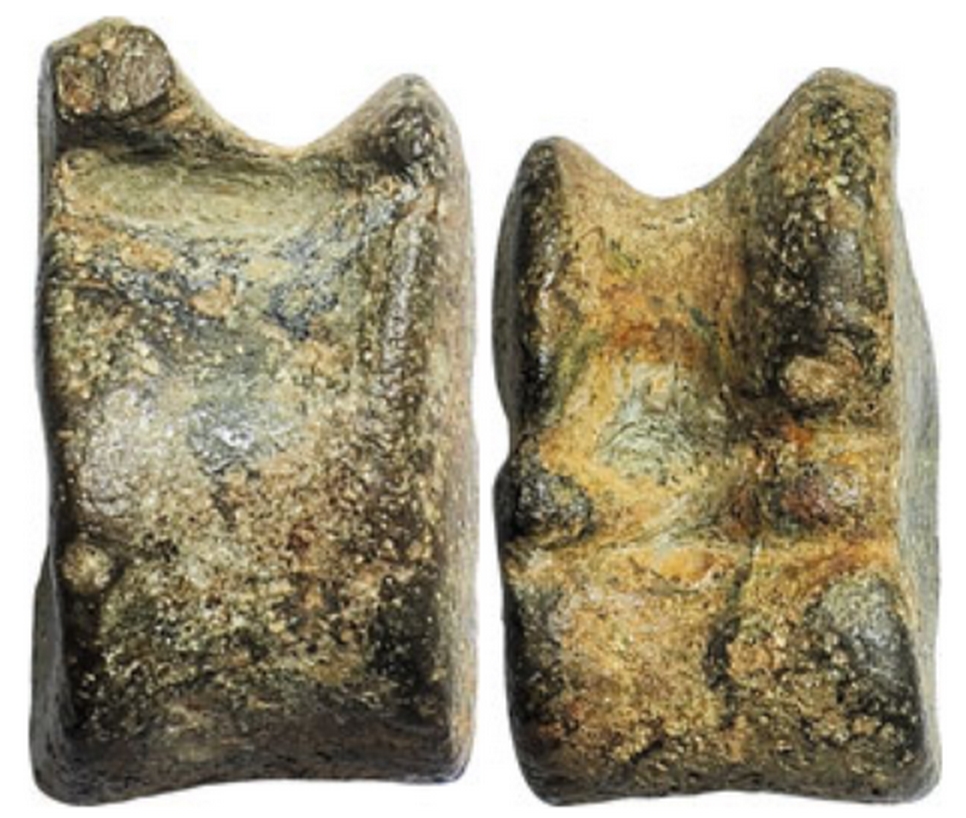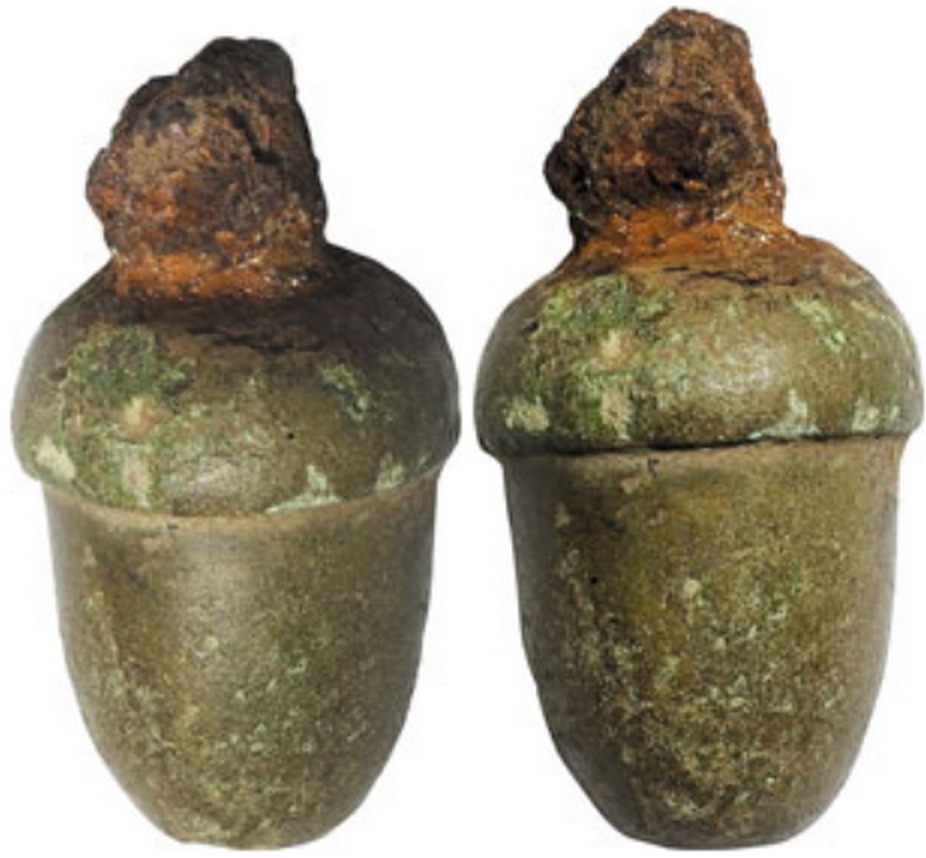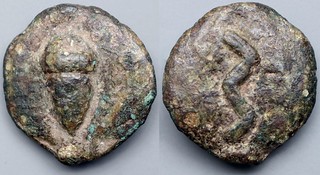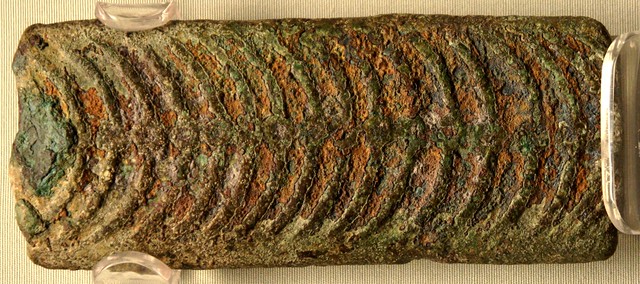Books: Money in Early Rome Coins: Bronze Bars and Rudera 600 BC to 300 BC
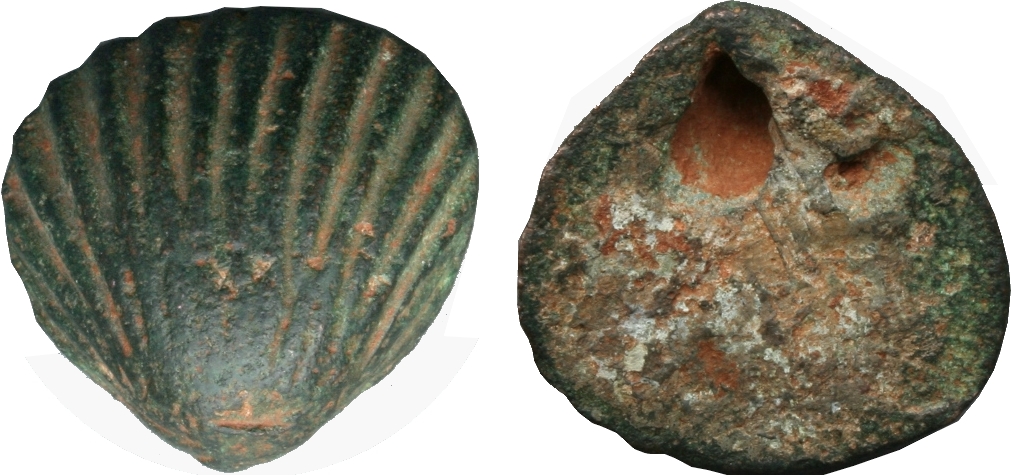
|
Links to Books: Money in Early Rome, Coins: Bronze Bars and Rudera:
- Bronze Bars and Rudera 600 BC to 300 BC Picture Set
- Money in Early Rome - Introduction
- A curious riddle: the livestock-branded bars of Servius Tullius
- Pecunia
- Mancipatio, Per Aes et Libram, and grabbing what is yours
- Libra and Stater, which came first, the Scales or the Weights?
- As: The Bronze Weight, the Bronze Standard
- Uncia, a little heap
- Congiarum, Acca Laurentia's 12 children, and sober inhospitable Romulus
- Stips, Pay-Chest, Stipend, Soldier's Pay, and Donativum, their Bonus
- Nummus and other words meaning A Coin
- Rudera and Aes Grave
- Aes Signatum and Aes Rude
- Shaped Money: scallops, acorns and knucklebones
- Prize Money and a magical Thunderbolt Triens
- Ramo Secco and Fishbone bars
Early Roman Money: Bronze Bars and Rudera 600 BC to 300 BC
Click on any photo to see that coin. Or click on the right-hand blue link to see the entire set.
600-300BC bronze bars, Romes conquest of Italy
Click for SLIDE SHOW of these coins
Click for DETAIL VIEW of these coinswww.flickr.com
![]()
500-320BC bronze bars, Romes conquest of Italy
According to Pliny, the measures of value used by the Romans before the reign of King Servius Tullius were rough pieces of bronze, which had to be weighed. At a still earlier stage cattle appears to have been the principal measure of value, as seen from various sources that quote fines in terms of oxen and sheep, and by the ancient linguistic link of the word pecunia to money. The transition from rough lumps of bronze, Aes Rude, to proper money, apparently took place during the reign of Servius Tullius, 578-535BC. By the time the Twelve Tables were enacted in 450 BC, fines in cattle were no longer mentioned but on the contrary fines were expressed in bronze, and indeed the measure of bronze was the As (pound). Pliny is not a very reliable source for numismatics, but there may be a germ of truth in the story. Just as Pliny's 269 BC date is now associated with the first Roman coinage actually struck in Rome (the wolf and twins didrachm) so his Servius Tullius account may relate to the production of bronze bars of reliable quality and branded to show so. In the web page below, this story of early money is for the first time fully explored with a host of good stories and illustrations.
Timeline Synopis for Money in Early Rome
The web essay which follows comments on the usage, dating and nomenclature of money in the Roman world before the arrival of coinage. For easier reference, here is a synopsis of the timeline that is discussed in the essay:
- From the earliest Roman kingdom, about 750 BC, bronze lumps that were randomly ferruginous or good quality copper. These were the original Aes Grave (massy bronze) or Rudera (unwrought ferruginous bronze). The Roman divisor of 12 is illustrated by Romulus donating a Congius (3.3 litres) of wine to be split amongst each 12 people, reflecting the 12 children of Acca Laurentia and the 12 Arval priests, hence also the word Congiarum as a gift to the populace. Mancipatio as an important form of transaction, the per Aes et Libram procedure that affirmed and acknowledged ownership rather than being a sale per-se. Weighing played a central role, and some weight and coin names including Libra and Stater arose from the acts of weighing.
- About 700 BC, military donatives by Numa Pompilius likely in good-copper adzes. A consistent hoard of adzes of that time is cited, from Ardea. The As is recognised as being a fixed pound of bronze.
- About 550 BC branding of good copper (the oft misinterpreted Servius Tullius quote) alike with how sheep and cattle are branded. Grammichele hoard is an early example of a simple brand, see illustrated pieces. Bitalemi hoard, dated 550BC by pottery within, contains technically more sophisticated Ramo Secco in relief but still of a simple brand design.
- 500 BC onwards, Fishbone bars from 500 onwards, allowing more precise value assessments and payments of tax or census monies in fractional amounts.
- 450 BC legal framework for transactions and fines in bronze Asses is reinforced with a flurry of laws.
- 500 BC - 300 BC Continued production of ferruginous bars, which were termed Aes Rude (red, unwrought) to distinguish them from bars with marks (with incuse brands, Ramo Secco, or Fishbones) that were termed Aes Signatum. Together constituted Aes Grave. Use of formed money - scallop shells, acorns, knucklebones - anticipates coinage and was reflected in the first coins.
- New Aes Signatum and coins from about 300BC. General term Aes Grave applied to all cast bronze; prior metal generally becomes referred to as Aes Rude.
Money in Early Rome
Money in Early Rome, Emilio Peruzzi, Florence 1985
This site's first review tackles Rome's earliest money. Life for numismatists starts with coins having graven images - identifiable, datable, coins that can be classified and pinned to an historical timeline without hesitation or deviation. So-called primitive money is just too tough a case. The very best archaeologists and historians combined can only say "probably 700 to 300 BC" or "pre-dates" coinage". Emilio Peruzzi has taken a different approach. He examines the etymology of words describing early money and compares them with literary tradition on money use, to reach conclusions on how money was used in practice, what the different bits of more-or-less ferruginous bronze illustrated in my first coin set above were used for, and how they might be dated. His work is still underpinned by established historical, literary and archaeological facts, so for example fully acknowledging that what we conventionally call Aes Grave and Aes Signatum both date from the third century BC and no earlier.
Words continue long in use whilst their meanings shift much more rapidly. The word Computer was a human accounting assistant who manually totted up numbers. A Car was a wood and horse vehicle which today we call a carriage. So it was with the early words on money. Peruzzi shows that many of the Roman words for money - Libra, Uncia, As, Stater, Dupondius, Aes Grave, Aes Rude, Aes Signatum, Nummus, Stipend, Congiarum, Donativum, Pecunia, Moneta - have a consistent evolutionary story that allows us to make perfect sense of their usage in historical record.
A Curious Riddle: the Livestock-Branded bars of Servius Tullius
When it is recorded that Servius Tullius, King of Rome 578 to 535 BC, first marked bronzes in the likeness of sheep and cattle - Servius Rex ovium bovumque effigie primum aes signavit - Pliny was aware that currency bars existed with animal pictures - the Aes Signatum with Cattle, Pigs and Elephants, and probably read into his historical readings that such bars dated from Servius. But this bull bar dating from about 300BC, is not and never was Servius' bar. It's a curious riddle.
Later numismatists simply discarded Servius' account as inconsistent with the archaeological and historical record which proves such bars to be 3rd century BC. But the linguistics and historical context make it much more likely that the original story was that King Servius Tullius first marked bronzes ALIKE with sheep and cattle - i.e. the bronze was BRANDED alike with how livestock are branded, with stamps such as on the bars below, and this was done to commend the metal quality as good copper.
Pecunia
Servius Tullius' Aes Signatum (marked Aes) thus had the mark of cattle or nota pecudum. The generic word from money, Pecunia, may derive from this nota pecudum or from prehistoric use of cattle as wealth, but for some two thousand years we - including Pliny - have been wildly misled by the coincidental existence of a single type of third century bar showing cattle into believing the word Pecunia derives from bars with a picture of cattle, rather than with a mark or brand. This makes sense also in context of early branded money in Lydia. The bar fragment here has a brand or mark impressed in incuse that looks somewhat like a helmet, and may be one of Servius' bars.
But this feature on bars of this exact shape and form has been noticed before. Below is a bar fragment from the Grammechele (Catania) hoard unearthed in 1900, and reported by Paulo Orsi after whom the Syracusan archaeology museum is named. Its technical features include a long and wide metal edge flashes not found on later bars, and the primitive stamp similar to that on the bar above. It was made of good copper. The Grammichele example is an uncanny match in every detail of its manufacture size and shape and Orsi in 1900 concluded that it bore a helmet-shaped stamp similar to what I noted; perhaps my above example is from the same hoard.
This find is likely datable to early 6th century BC, earlier than the more sophisticated Ramo Secco bars of which one was found in the Bitalemi hoard with pottery than date from mid 6th century BC. Not only do the Ramo Secco bars have relief design for the first time, in the shape of the veins of a dried leaf, but their outside form is different from the Grammechele bars illustrated above, lacking their wide-edged casting sprues. With the Bitalemi Ramo Secco bar there were found many shapeless pieces of bronze, iron fragments, and a broken adze, and the hoard was found in a datable stratigraphic level with Greek pottery dated to about 550BC. Photo courtesy Artemide Aste.
A further fragment, a slice from a pancake bar, is clearly stamped with a Sigma at the top right, and possibly other stamps too. This is a fragment of a round pancake bar that in its complete form would have weighed several kilos. Each of these marked bars appear of excellent copper quality. Such branded copper likely was that first currency referred to in the stories of Servius Tullius, widely ignored by later numismatists who had not deciphered the riddle.
Mancipatio, Per Aes et Libram, and grabbing what is yours
Peruzzi starts with a discussion on the transaction known as "per Aes et Libram" (by bronze and scales), dating from the time of the Roman Kings. Understanding the earliest transactions is key to understanding the money. This later came to be known as Mancipation and was a sale process that involved weighing the purchase price in front of five witnesses. The later association of the word with slavery (and its reverse, emancipation) no doubt related to slave-purchase requiring money rather than spare chickens to accomplish. But there are curiosities in the form of words and of the transaction that hold clues. Literally it means to accept by hand. The buyer had to hold the thing by hand (grasping the slave or sheep or whatever) and in front of the five witnesses utter a fixed form of words, which Romans preserved carefully into later times, "I affirm that this thing is mine by Quiritary (citizenship of Rome) right and he is taken by me by this bronze and the bronze scales". Afterwards he strikes the scales with bronze and gives the bronze as a symbol to him from whom he is receiving by mancipation.
What is really going on here? The Wikipedia entry on Mancipation uses the word "purchased" rather than "taken", and misses all of the subtleties. There is no purchase going on. Instead there is a declaration of ownership at the start - not at the end - of the transaction, followed by a symbolic act in front of witnesses that the prior owner does not object to. The concept of purchasing for money had not yet been established when this ancient formula was born. Money, as a measure and store of value, was on the very cusp of invention. Barter, between two end-products which both parties could eat, work, cover themselves with, build or plough, was all there was. But no doubt in even more ancient times than that of the Roman Kings, when ownership was under dispute, it had been usual to grasp the object and say "this is mine" in front of your neighbours. The novel aspect was the introduction of scales, Libra, into the process, and here there are a swathe of clues about the origin of the words for money. Pictured below are a couple of later Republican types illustrating scales.
Libra and Stater, which came first, the Scales or the Weights?
That the word for pound and scales are the same comes as no surprise - it might be assumed that the latter stems from the former - but comparison with the etymology of Stater brings a surprise. Stater is a Greek word for a weight and for money, but in Latin Statera means a steelyard balance (also, oddly, known as a Roman balance or Roman steelyard) such as shown below. Peruzzi shows that the Latin word Statera was likely borrowed from Greek, through trade, from an early time when the Greek word also meant a weighing device but did not yet mean a weight or money.
Libra, from the Greek Litra has a similar story. The Greek Litra was, as with Stater, later only known as a weight or a coin whereas to the Romans it is also a scales. But etymology suggests an early basis in the Greek word ΛΙΑΖΩ, let down, lower, and ΛΙΑ, weighty. Thus the lowering action of the scales becomes synonymous with the act of weighing. Litra finds its way into Latin Libra with the act of weighing still inherent in the word for scales, just as Stater does for the steelyard balance, yet these words as weighing implements are lost to Greek itself.
As: The Bronze Weight, the Bronze Standard
Coming back to "per Aes et Libram" it was thus the act of weighing that gave the name to the weight, Libra, and not the other way around. In the primitive context of "per Aes et Libram", the scales were the high-technology addition to a declaration of new ownership and thus merited the title. But what of the word As? Why is it different from Libra? Good old Peruzzi takes out his dictionaries and proposes that it has its Greek origin in words such as draw-down (as in draw water), it is what draws down the scale, the fixed weight, the standard, a single object in bronze that weighs a Libra. Whereas on the other side of the scales could be a mess of objects that make up a Libra. This is a quite perfect example of an As, weighing 327 grams. Isn't this a lovely object!
Uncia, a little heap
But a Libra could be made up of many of these; or indeed of non-bronze objects, whereas an As is always bronze. As to why a Libra weighed what it did - and not for example 2 kilos or 50 grams - one might imagine the original standard stemming from the amount of grain needed for a day, or the amount one could hold in two hands. Uncia / Onkia may stem from a heap, or small pile, the loose change of the Roman Kingdom, or some of those small fragments.
And a Dupondius, alone of the As multiples to have this form, is literally "two weights", consistent with the concept of the As as "the weight". It almost provokes a double-take when one realizes that although it looks as if it should mean "two pounds" it certainly does not, since Libra is a pound, and Pondus is a weight.
Congiarum, Acca Laurentia's 12 children, and sober inhospitable Romulus
Two other words, Congiarum, a gift from the Emperor to his people, and Donativum, the military equivalent, have interesting origins, and the first of these sheds light on the division of twelve that is pervasive in Roman times, not least the twelve Unciae in an As. Romulus, whose true portrait is undoubtedly shown on this coin of Quintus Cassius, was brought up by the shepherd Fostulus and his wife Acca Laurentia. Everyone knows the wolf and twins story, and Pompeia's coin showing and naming Fostulus, but the coin of Accoleia at the right, and showing Acca Laurentia, is less famous.
Acca Laurentia had twelve natural children. When one of them died, her adoptive son Romulus, King of Rome 753 to 716 BC, publicly took his place as her son and from then the twelve sons were referred by him as the Arval brothers, or "brothers of the fields", a priesthood that was to last a thousand years - records exist in the third century AD - with replacements inducted on a death, as with Romulus' original induction into the family. To commemorate the brotherhood of twelve he gave a Congius of wine to be divided amongst every twelve citizens, a tiny amount but wine was a very scarce commodity at that point in Rome, and even religious sacrifices were done with milk. Thus originates Congiarum, but it also hints to the division of twelve that later appeared in the currency between a small heap of bronze fragments, or Uncia, and a substantial weight or As. By the by, Romulus sounds a rather dull and temperate fellow. There is a little story that someone noting how little wine Romulus drank said that if everyone drank like you then wine would be much cheaper and easy to get. Romulus replied that, in contrary, he had drunk his fill, and if everyone likewise drunk until they were sated, wine would be much dearer and hard to find!

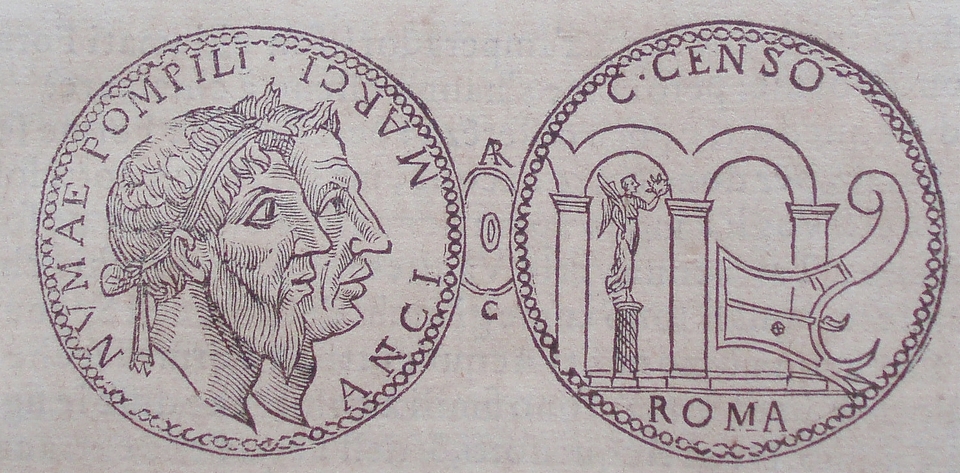
Stips, the Pay-Chest, Stipend, the Soldier's Pay, and Donativum, their Bonus
Now the Donativum, the soldier's equivalent to a Congiarum. In the time of Numa Pompilius, King of Rome 716 to 674 BC, a Donativum is recorded, amounting to two and a half pounds "cut in bronze", or Aere Incusum. Stips, the base of Stipend (weighing Stips) or army pay has an etymology that point towards a big mass of bars crammed together, the army pay-chest. A large hoard of broken adzes was found in th 1960s in Ardea, some 35km south of Roma, and has been dated to the late 8th century BC, i.e. the times of Numa Pompilius. It looks just what a Stips might be expected to consist of, some two hundred adzes, all damaged in one or other way and typically weighing 550 to 800 grams per item, very close to the recorded Donativum of two and a half pounds cut in bronze. Was the original Donativum a disbursement of broken tools amounting to an approximate adze-weight per person, cut, weighed and doled out? Bronze was indeed valuable at that time, can one imagine a soldier of Julius Caesar settling for a broken axe-head as his pension! My axe-head here matches the story in every respect, being both damaged and also cut no doubt to make an exact weight. Might this very axe have been part of the original Donativum, or indeed originate in the Ardea hoard? Another lovely item.
Nummus and other words meaning Coin
Nummus is not a Roman denomination but appears in our modern terminology for some Italian coinage during the Roman Republican period, so requires comment. It is today what we call an As for those non-Roman cities or cities which used a non-Roman weight standard for example the decimal system with ten Unciae to a unit. The Roman Dextans of Luceria is often termed a Nummus when that denomination is struck by an Italian city under its own name. We use the word Nummus as meaning money-unit, indeed as a parallel with the concept of As that I've explained above. But this is simply a term of modern convenience and loose-language. In Roman times, Nummus meant "Coin" or "Money piece" - which could be a money bar - and nothing else. It was never a denomination. Where we use the word Nummus today, we should say As.
In one of those language changes I've referred to constantly, by Roman Imperial times Stips also became a word meaning "Coin" when its origins as meaning a crowded mass of metal in the pay-chest were lost to history, and it was assumed that since a soldier's stipend was paid in coins then Stips must mean Coin.
The term Moneta, which many today think to have always been synonymous with Money or Coin, never was any such thing. Moneta, referred to Juno Moneta's peculiar capacity for warning, but was later to lend itself to the name of the workshop responsible for minting coins at that temple. The coins thenceforth also became known in time as Moneta.
Rudera and Aes Grave
I leave for last the tricky subject of Aes Rude, Aes Signatum and Aes Grave. Those that have read widely on early Roman currency already know that these terms are not quite used correctly. To start with, what we today call Aes Rude was referred to by the Romans as Rudera, a fragment of unwrought bronze, such as I illustrate above. Peruzzi proposes an etymology that has nothing to do with the words rude or rough, but rather stems from the ancient word RED, found in all Indo-European tongues in one or other form. Unwrought metal, or ferruginous bronze is indeed a reddish colour, and rudusculum, meaning unwrought metal, likely stemmed from its colour. Aes Infectum, or raw bronze was a more technical definition used by the Romans, but Rudera, as a small piece of unwrought bronze, was more widespread in the common language due its practical use in "per Aes et Libram" into Roman Imperial times. In the procedure where it says "strike the scales with bronze", either a struck As was used, or preferably a Rudera, an unwrought fragment that had embedded within it the memory of ancient times when all money was Rudera.
Aes Grave literally means Massy or Heavy Bronze, it was bronze by weight, in mass. The early bars that were not marked, and were made of red ferruginous copper, were Aes Grave in its literal sense. The example below is almost proto-typical. The colour is right and red, it is heavy and massy, it is unwrought, it is not stamped. This is all that Aes Grave should be, an ancient word that likely preceded Aes Signatum.
Aes Signatum and Aes Rude
When Aes Signatum appeared, possibly during the reign of Servius Tullius as per the historical record, these stamped good copper bars needed a language distinction from the older unmarked and ruder bars. For this the term Aes Rude makes complete sense. Aes Rude are the massy heavy bars that are not Signatum, are not stamped, are likely rough unwrought and reddish ferruginous bronze. The bar above is indeed Aes Rude, to distinguish itself from Aes Signatum, the marked good-copper bars I showed, which developed in time into the Ramo Secco (dried leaf) pattern and Fishbone bars, and ultimately to the figurative bars and round coins of the third century BC.
Consider Aes Grave as being the overall term for massy or heavy bronze, whilst Aes Signatum and Aes Rude are distinctions between the marked and unmarked Aes Grave, and Rudera the unwrought fragments. But so as not to confuse readers with uncommon terms, I will use conventional usage for the remainder of this website.
Shaped Money
One form of early money that Peruzzi does not directly address are the shaped objects, most usually scallop-shell, and more rarely knucklebone and acorn types.
Curiously the Romans themselves acknowledged these as part of their numismatic history by reproducing the three types, scallop-shell, knucklebone and acorn, on the small denominations of their new round coinage in the early third century BC. Formed Acorn and Knucklebone photos courtesy of Artemide Aste. No doubt the denominations were referred to by the name of the object, thus two acorns and a knucklebone amount to a scallop-shell!
Prize Money and a magical Triens
However a parallel example is discussed, the Triens that very likely was called a Thunderbolt, of which a remarkably fine example is shown below. Fulmens is the usual term for a thunderbolt, but Manubia is another word; Manubiae also means prize-money. Could there have been a connection? Quite possibly, the Romans did respect their money and talk about it. Philemon Holland, 1552 - 1637, who translated many Latin works into English, recounts the following story from Pliny about a most noble Triens. Quote. "There is (you know) the noble Servilia family, well renowned, from their appearance in the Roman calender and acts of record. They have among them a certaine piece of brass coin called a triens (the third part of a common As) which they keep and feed with silver and gold. For eat and consume it does both the one and the other. From whence it came first, and what the reason in nature of this Triens are, I know not yet. But for my warrant, I will set down the very words of old Messala: The house (quoth he) of the Servilia hath a certain sacred Triens, in the honor of which they do sacrifice yearly with great devotion and solemnity, omitting no magnificence nor ceremonies. And all commonly say that this Triens seemd one while to grow bigger, and another while to diminish and be smaller : according to which increase or decrease, the said Servilia take presage, that their family shall either rise to more honour, or decay in credit and reputation". Of all the coin types that this may refer to, wouldn't the Thunderbolt Triens be the most likely?
Ramo Secco and Fishbone bars
The very last lump of metal in this story is a Fishbone Aes Signatum bar. Aes Signatum started with the branding of metal, probably first just stamps as done with cattle or sheep, then later the more sophisticated dried-leaf pattern such as this British Museum Ramo Secco bar. As noted, the archaeological record shows such pieces as early as 550 BC, and likely later than my more primitive early stamped piece.
Most such bars are eventually found broken for change which of course is a one-way process; you cannot reform a big bar once taken apart. A logical stepping stone en-route to coinage and money that could be counted, was to have some means to indicate the value of a broken bar, and the Fishbone bars - also found archaeologically from about 500 BC - was a very neat solution. They could be cut to any number of fish-spines, and the size and value could be assessed visually by counting. Countable coinage would be the next step which however took the Romans a further 200 years, to 300 BC. But in this period there is a wealth of evidence of the widespread use of money from both hoard finds and the literature. Indeed there was a buzz of legislation in the mid fifth century BC that was clearly set out in the context of a well monetized economy; the Lex Aternia Tarpeia of 454 BC, the Lex Menenia Sestia of 452 BC and of course the Twelve Tables of 451 BC.
In closing, whilst many of the references in this discussion stem from Peruzzi's book, I am not endorsing his actual conclusions on the etymology of specific words. One or more of these may well be nonsense, yet the bigger story would remain intact, that of how money was used and referred to in the early Roman Republic.
All content copyright © 2004-2013 Andrew McCabe unless otherwise noted. If you've any questions or comments please contact me on the Yahoo Group RROME: http://groups.yahoo.com/group/RROME.
Alternately you can leave comments against any coin picture, just click on the picture and write in the comment box.
